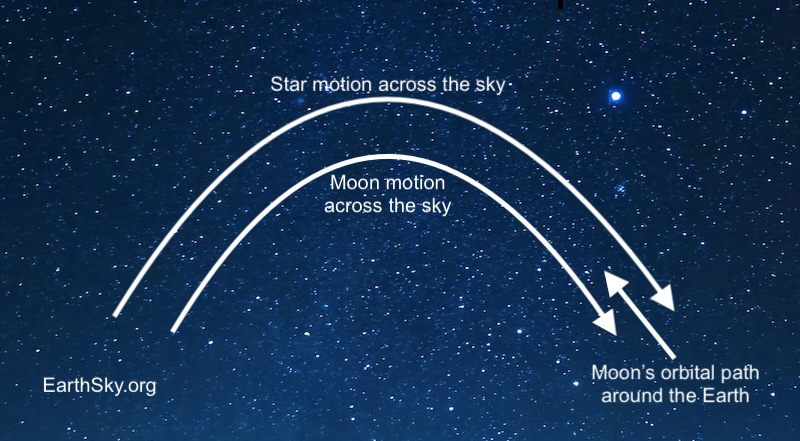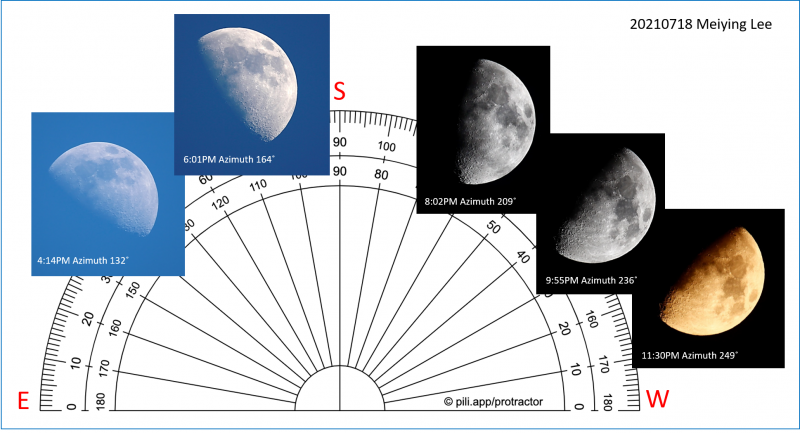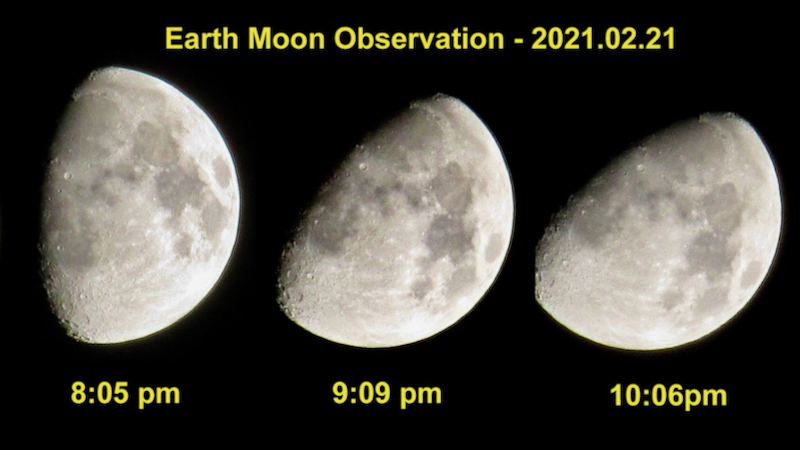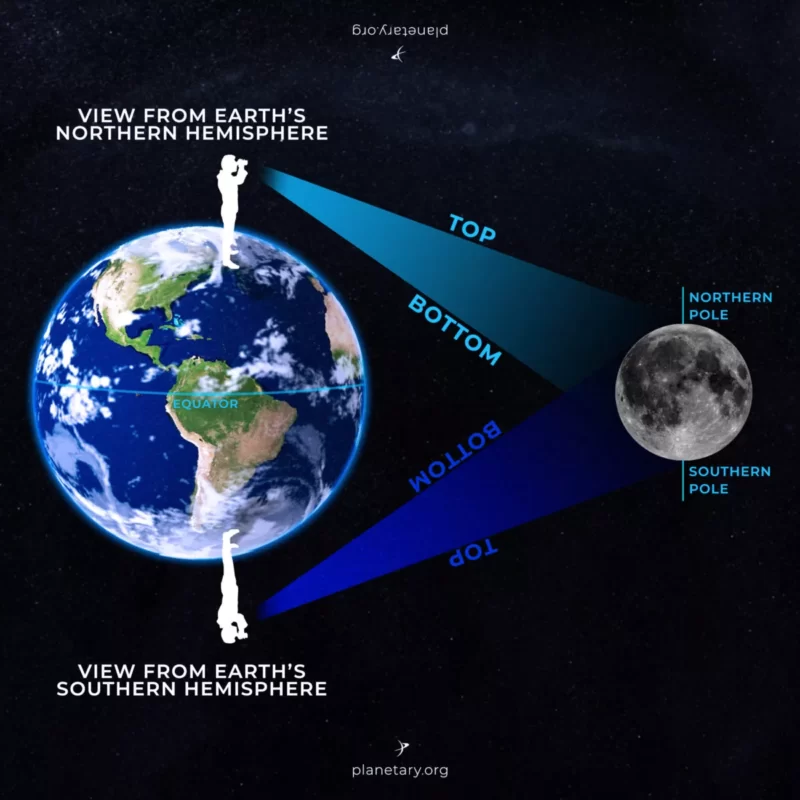Moon phase is a whole-Earth phenomenon
Everyone looking up at the moon from any spot on the globe sees the same moon, in more or less the same phase. So why might photos of the moon taken on a single night – but from different parts of Earth – look different?
And also, here’s a related question. Why does the moon look different – even from the same spot – over the course of a single night?
Let’s take the second question first. The moon’s orientation with respect to your horizon shifts throughout the night because we live under a curved dome of sky. Think of the curved arc traveled by the sun during the day. The moon and the stars follow similarly curved paths.
The illustration below shows the curved line traveled by the stars and the moon, as they traverse Earth’s dome each night (or day). And that is because Earth’s rotation under the sky causes the stars and moon to move westward throughout the night. However, the moon’s motion in its orbit around Earth each day is eastward, in front of the background stars.
The 2024 lunar calendars are here! Best Christmas gifts in the universe! Check ’em out here.

How the moon changes over hours
Overnight – or even in a few hours – you can notice the appearance of the moon changes.


How the moon changes between hemispheres
So now, why do people in different parts of the globe, see the same moon phase, but it appears different? People in the Northern and Southern Hemispheres see the moon oriented differently from one another. It’s not a change in phase. It’s a change in the orientation of the moon with respect to your horizon. The differences can be hard to comprehend!
For one thing, observers in the Northern and Southern Hemispheres see the moon apparently upside-down with respect to each other. You can see that, if you scrutinize the moon’s features in the image below.

Also, notice that from the Northern Hemisphere, a waxing moon (from new moon to full moon) increases its phase from right to left. Meanwhile, from the Southern Hemisphere, a waxing moon (from new moon to full moon) increases its phase from left to right.
Have you ever been to the southern hemisphere Ashes??
Ever see the Southern Cross? Sigma Octantis?
The sun moving from right to left each day?
The stars moving clockwise each night?
The moon phases move from left to right over 28 days?#SouthernHemisphereDisprovesFlatEarth pic.twitter.com/pfESD411yH— Rozzie (@RozzieVox) November 18, 2019
Why so different? Think of the moon’s path across your sky. Just picture yourself standing there, looking at it. From the Northern Hemisphere, we look generally southward to see the moon (or sun) crossing our sky. From the Southern Hemisphere, people look generally northward to see the moon (or sun) crossing the sky.
Can you see why that shift in your orientation on the globe would cause you to see the moon differently?
A final thought
What we on Earth call moon phases are really about sunrise and sunset on the moon. Astronomers call the line between light and dark on the moon the terminator line. That’s the line of sunrise or sunset on the moon, and it shifts, just as the line of sunrise and sunset on Earth is constantly shifting.
Also, Earth spins relatively fast, approximately once every 24 hours. The moon spins on its axis only once each earthly month, and its line of sunrise/set moves slowly. It’s wonderful fun to beg or borrow a telescope for a night when the moon is up … and watch for yourself over several hours as the shadows slowly shift on the moon, as the lunar sunrise or sunset slowly creeps across the moon’s face.
Of course, it’s also a great way to clear the mind!
Bottom line: The moon shows one phase to the Earth at the same time, but our different perspectives due to where we are on the globe can make the moon appear differently in our sky.
Want more? Visit phases and orbits of the moon
The post Do we all see the same moon phase from Earth? first appeared on EarthSky.
from EarthSky https://ift.tt/mWNFhiY
Moon phase is a whole-Earth phenomenon
Everyone looking up at the moon from any spot on the globe sees the same moon, in more or less the same phase. So why might photos of the moon taken on a single night – but from different parts of Earth – look different?
And also, here’s a related question. Why does the moon look different – even from the same spot – over the course of a single night?
Let’s take the second question first. The moon’s orientation with respect to your horizon shifts throughout the night because we live under a curved dome of sky. Think of the curved arc traveled by the sun during the day. The moon and the stars follow similarly curved paths.
The illustration below shows the curved line traveled by the stars and the moon, as they traverse Earth’s dome each night (or day). And that is because Earth’s rotation under the sky causes the stars and moon to move westward throughout the night. However, the moon’s motion in its orbit around Earth each day is eastward, in front of the background stars.
The 2024 lunar calendars are here! Best Christmas gifts in the universe! Check ’em out here.

How the moon changes over hours
Overnight – or even in a few hours – you can notice the appearance of the moon changes.


How the moon changes between hemispheres
So now, why do people in different parts of the globe, see the same moon phase, but it appears different? People in the Northern and Southern Hemispheres see the moon oriented differently from one another. It’s not a change in phase. It’s a change in the orientation of the moon with respect to your horizon. The differences can be hard to comprehend!
For one thing, observers in the Northern and Southern Hemispheres see the moon apparently upside-down with respect to each other. You can see that, if you scrutinize the moon’s features in the image below.

Also, notice that from the Northern Hemisphere, a waxing moon (from new moon to full moon) increases its phase from right to left. Meanwhile, from the Southern Hemisphere, a waxing moon (from new moon to full moon) increases its phase from left to right.
Have you ever been to the southern hemisphere Ashes??
Ever see the Southern Cross? Sigma Octantis?
The sun moving from right to left each day?
The stars moving clockwise each night?
The moon phases move from left to right over 28 days?#SouthernHemisphereDisprovesFlatEarth pic.twitter.com/pfESD411yH— Rozzie (@RozzieVox) November 18, 2019
Why so different? Think of the moon’s path across your sky. Just picture yourself standing there, looking at it. From the Northern Hemisphere, we look generally southward to see the moon (or sun) crossing our sky. From the Southern Hemisphere, people look generally northward to see the moon (or sun) crossing the sky.
Can you see why that shift in your orientation on the globe would cause you to see the moon differently?
A final thought
What we on Earth call moon phases are really about sunrise and sunset on the moon. Astronomers call the line between light and dark on the moon the terminator line. That’s the line of sunrise or sunset on the moon, and it shifts, just as the line of sunrise and sunset on Earth is constantly shifting.
Also, Earth spins relatively fast, approximately once every 24 hours. The moon spins on its axis only once each earthly month, and its line of sunrise/set moves slowly. It’s wonderful fun to beg or borrow a telescope for a night when the moon is up … and watch for yourself over several hours as the shadows slowly shift on the moon, as the lunar sunrise or sunset slowly creeps across the moon’s face.
Of course, it’s also a great way to clear the mind!
Bottom line: The moon shows one phase to the Earth at the same time, but our different perspectives due to where we are on the globe can make the moon appear differently in our sky.
Want more? Visit phases and orbits of the moon
The post Do we all see the same moon phase from Earth? first appeared on EarthSky.
from EarthSky https://ift.tt/mWNFhiY

Aucun commentaire:
Enregistrer un commentaire